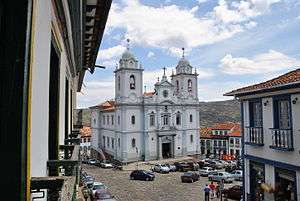Diamantina, Minas Gerais
 | |
| UNESCO World Heritage Site | |
|---|---|
| Location |
Minas Gerais, Brazil |
| Coordinates | 18°14′56″S 43°36′00″W / 18.2489°S 43.6°W |
| Criteria | ii, iv |
| Reference | 890 |
| Inscription | 1999 (23rd Session) |
| Website |
www |
 Location of Diamantina, Minas Gerais | |
Diamantina (Portuguese pronunciation: [dʒiamɐ̃ˈtʃinɐ]) is a Brazilian municipality in the state of Minas Gerais. Its estimated population in 2006 was 44,746 in a total area of 3,870 km².
Arraial do Tijuco (as Diamantina was first called) was built during the colonial era in the early 18th century. As its name suggests, Diamantina was a center of diamond mining in the 18th and 19th centuries. A well-preserved example of Brazilian Baroque architecture, Diamantina is a UNESCO World Heritage Site.
Other historical cities in Minas Gerais are Ouro Preto, Mariana, Tiradentes, Congonhas and Sabará.
Statistical micro-region
Diamantina is a statistical micro-region that includes the following municipalities: Diamantina, Datas, Felício dos Santos, Gouveia, Presidente Kubitschek, São Gonçalo do Rio Preto, Senador Modestino Gonçalves, and Couto de Magalhães de Minas. The area of this region is 7,348 km² and in 2006 the population was 80,063 inhabitants. The population density (2000) was 11.2 inhab/km².
Location

Diamantina is located 292 kilometers almost directly north of the state capital, Belo Horizonte, in a mountainous area. The elevation of the municipal seat is 1,114 meters. The Jequitinhonha River, one of Brazil's most important rivers, flows to the east of the municipal seat. Diamantina is linked to the state capital by federal highway BR-259, by way of Curvelo. Diamantina Airport has regular flights to Belo Horizonte.
The municipality contains the 16,999 hectares (42,010 acres) Biribiri State Park, created in 1998, which contains the historic village of Biribiri.[1]
Neighboring municipalities are: Olhos d'Água and Bocaiúva (N); Carbonita, Senador Modestino Gonçalves, São Gonçalo do Rio Preto, and Couto de Magalhaes de Minas (E); Santo Antônio do Itambé, Datas, Serro and Monjolos (S); Augusto de Lima, Buenópolis, and Engenheiro Navarro (W).
Economic activities
The main economic activities are tourism, services, small industry and agriculture. The GDP in 2005 was R$184 million, with 140 million coming from services, 23 million from industry, and 8 million from agriculture. In 2006 there were 1,248 rural producers on 73,000 hectares of land. Only 24 of the establishments had tractors. There were 14,000 head of cattle.[2]
Health and education
The social indicators rank Diamantina in the top tier of municipalities in the state.
- Municipal Human Development Index: 0.748 (2000)
- State ranking: 298 out of 853 municipalities as of 2000
- National ranking: 1933 out of 5,138 municipalities as of 2000
- Literacy rate: 86%
- Life expectancy: 68 (average of males and females)
- Infant mortality: 32.8
The highest ranking municipality in Minas Gerais in 2000 was Poços de Caldas with 0.841, while the lowest was Setubinha with 0.568. Nationally the highest was São Caetano do Sul in São Paulo with 0.919, while the lowest was Setubinha. In more recent statistics (considering 5,507 municipalities) Manari in the state of Pernambuco has the lowest rating in the country—0,467—putting it in last place.[3]
There were 2 hospitals and 31 health clinics in 2005. Educational needs were met by 30 primary schools and 9 middle schools.[2]
There were 3 institutions of higher learning: Faculdade de Ciências Jurídicas de Diamantina - FCJ (a law school), Faculdade de Filosofia e Letras de Diamantina - FAFIDIA (humanities), and Universidade Federal dos Vales do Jequitinhonha e Mucuri - UFVJM (federal public).[4]
Famous natives of Diamantina

- Chica da Silva, an enslaved African-Brazilian folk heroine became first lady in the region, after having married a Luso-Brazilian ruler; born circa 1730. Adaptations of her story were made into songs and famous soap operas translated into other languages.
- Alice Dayrell Caldeira Brant (pseudonym: Helena Morley), whose diary Minha vida de menina (translated into English as The Diary of Helena Morley) is a classic in Brazilian literature; born in 1880; died 1970.
- Juscelino Kubitschek de Oliveira, responsible for the creation of the new capital, Brasília, President of Brazil from 1956 to 1961; born in 1902.
- José Vieira Couto de Magalhães, Brazilian general and folklorist; born in 1837.
International relations
Twin towns — Sister cities
Diamantina is twinned with:
 Třeboň, Czech Republic
Třeboň, Czech Republic
Related subjects
| Wikimedia Commons has media related to Diamantina. |
- Minas Gerais
- Ouro Preto
- List of municipalities in Minas Gerais (MG), Brazil
- Roman Catholic Archdiocese of Diamantina
External links
-
 Diamantina travel guide from Wikivoyage
Diamantina travel guide from Wikivoyage - (in Portuguese) Official homepage
References
- ↑ "Parque Estadual do Biribiri", Descubra Minas (in Portuguese), Senac Minas, retrieved 2016-11-30
- 1 2 IBGE Archived January 9, 2007, at the Wayback Machine.
- 1 2 Frigoletto
- ↑ Mundo Vestibular
Coordinates: 18°14′56″S 43°36′00″W / 18.249°S 43.600°W

